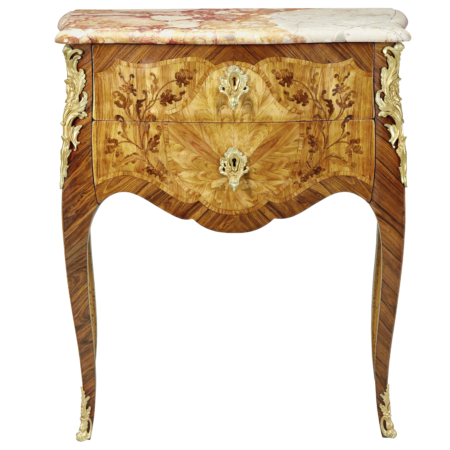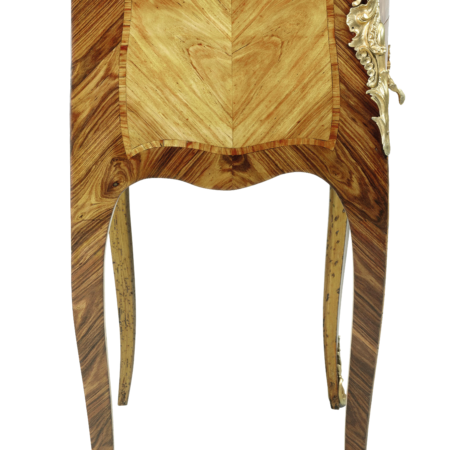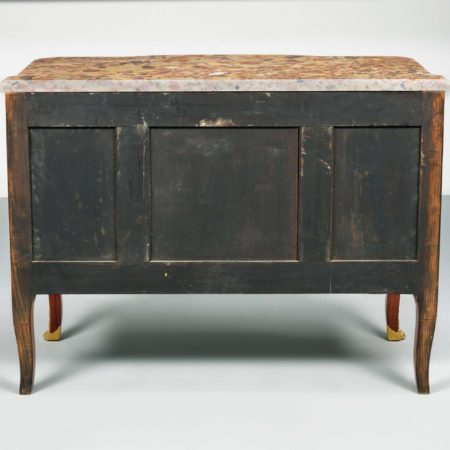Chest of drawers and sideboards
-

 Sold
Sold
- Epoch Louis XV (second half of the 18th century).
- Various softwoods and hardwoods, rosewood veneered, marked with rosewood and various precious woods.
- Polished, two drawers at the front
- Gilt bronze mountings
- Striking stamp J.F. GRIFFET
- Dimensions: 82,5 x 72,5 x 42,5 cm
- Subject to species protection (ASB)
Chest of drawers and sideboards
Chest of drawers originally goes back to the simple wooden chest, which, along with the table and armchair, was one of the first pieces of furniture “invented” by humans.
Chests were built to store weapons, clothing and various valuable household items. The chests were always on the floor, usually in front of a wall. This meant that they were often exposed to moisture, which was bad for the wood and the objects stored inside. Woodworm could also multiply quickly in this damp environment, especially as softwoods were almost always used because of the ease of processing. For this reason, chests from before the Middle Ages have rarely survived. Gothic chests can be found again and again, but they usually bear heavy traces of worm infestation.
Over time, carvings began to be added to chests and so it became not only useful but also artistically valuable furniture. The construction of chests reached its peak during the Renaissance. They were already mostly made of walnut or oak, richly carved and often elaborately painted. At this time, Italy produced the most magnificent furniture, which served as models for the whole of Europe.
To protect it from moisture, the chests were placed on short legs. However, it was still difficult to remove the contents, which lay on top of each other, because everything that lay on top of the chest had to be removed first. So the chest became a classic chest of drawers, a piece of furniture with a fixed lid but with several drawers. This is the form in which they are still made today, although there are now also examples with hinged or sliding doors. At the same time, especially during the Renaissance, sideboards were built that were mainly used for tableware.
Chests of drawers with drawers became really popular only from the half of the XVII century. In the Louis XIV period, they are already elevated to the main furniture of the room.
While they were popular with every social class in simple designs because they were above all practical, they were stylised into works of art in castles and palaces. A chest of drawers like the one Louis XIV ordered for his state rooms in Versailles could cost more than an apartment building. The king had to wait up to 2 years until it was finished.
With time, styles and fashions changed, instead of an impractical marked top, slabs of marble were used more and more often. Although since the second half of the XVII century France became the country that determined the style, various European countries (Italy, England, Holland, Sweden, Switzerland, Germany, to name the most important) developed different variations of style and produced their own master levelists.
France’s unequivocal dominance in furniture making lasted through several epochs that spanned more than 2 centuries. These epochs of furniture making are named after the respective reigning king or the political system that prevailed at the time.
So today we recognise on the basis of the typical stylistic features:
- Louis XIV chests of drawers that still belong to the late Renaissance period
- Regence chests of drawers that already fall under “Baroque
- Louis XV chests of drawers, in the style called “Roccoco” in Italy and Central Europe
- Transitional chests of drawers marking the transition between Louis XV and Louis XVI
- Louis XVI chests of drawers, also known as Early Classicism
- Directoire chests of drawers were created after the French Revolution in 1789. Revolution in 1789 and were strikingly simple.
- Consulate Chests of Drawers, c. 1800-1805, after Napoleon Bonaparte became First Consul
- Empire Chests of Drawers, from the Time of Emperor Napoleon Bonaparte
- Louis Philippe chests of drawers, from the time when “Biedermeier” became the current style in Central Europe.
- Napoleon III chests of drawers, take models from all past epochs and simply copy them, or mix them into an eclectic whole.
You can find a more detailed description of the various styles in our BLOG.




